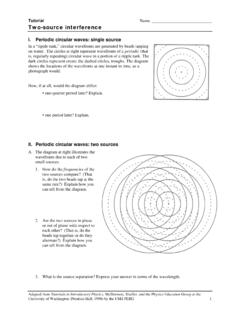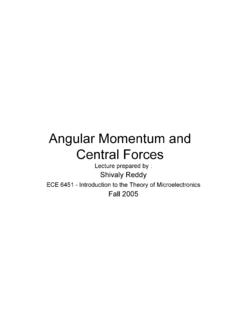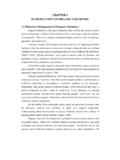Transcription of Introductory Lectures on Black Hole Thermodynamics
1 Introductory Lectures on Black hole Thermodynamics Ted Jacobson Institute for Theoretical Physics University of Utrecht Abstract These notes are based on five Lectures given at the University of Utrecht in early 1996. My intention was to introduce the subject of Black hole Thermodynamics starting at the beginning, at a level suitable for anyone with a passing acquaintance with general relativity and quantum field theory. Although the approach is elementary, several aspects of current research are discussed. The coverage of topics is very uneven. Properties of classical Black holes and both classical and quantum Black hole Thermodynamics are treated.
2 The selection and focus is determined by my idiosyncracies, time limitations, and an effort to illuminate some topics that have not traditionally been emphasized. Vast amounts of interesting and important work on the subject are not mentioned. I am very grateful to the Institute for Theoretical Physics for the hospitality and support they have provided during a very stimulating sabbatical year I spent there. Contents 1 Black hole basics 3. What is a Black hole ? .. 3. Newtonian viewpoint .. 3. Black hole types .. 3. Black hole metric .. 3. General references .. 5. Black hole uniqueness .. 5. Positive energy theorem .. 5. Singularity theorem.
3 6. Energy extraction .. 7. Converting mass to energy .. 8. Ergoregions .. 8. Penrose process .. 8. Charged Black holes .. 9. Area theorem .. 10. Applications of the area theorem .. 11. 2 Classical Black hole Thermodynamics 12. The four laws of Black hole mechanics .. 12. Black hole temperature as surface gravity .. 13. Zeroth Law .. 13. First law .. 13. Second and Third Laws .. 14. Generalized second law .. 15. Post-Einsteinian corrections .. 15. Thermodynamic temperature .. 16. 3 Quantum Black hole Thermodynamics 18. The Unruh effect .. 19. Symmetries of Minkowski spacetime .. 19. Two-point function and KMS condition .. 20. The vacuum state as a thermal density matrix.
4 21. Correlations in the vacuum .. 23. The Hawking effect .. 25. Gravitational acceleration radiation .. 26. Evaporation .. 26. Pair creation at the Black hole horizon .. 26. The transplanckian puzzle .. 27. Generalized second law revisited .. 29. Evaporation .. 29. Box-lowering .. 29. Mining a Black hole .. 30. General arguments .. 30. 1. Meaning of Black hole entropy .. 31. Holographic hypothesis .. 32. Formation degeneracy .. 32. Thermal entropy of Unruh radiation .. 33. Entanglement entropy .. 33. Species problem .. 34. Quantum gravitational statistical mechanics .. 34. A General Relativity in a nutshell 37. Newtonian gravity .. 37. Spacetime.
5 37. Geodesic equation .. 37. Curvature and Einstein equation .. 38. Symmetries and conservation laws .. 38. 2. Chapter 1. Black hole basics What is a Black hole ? Newtonian viewpoint In Newtonian physics, the escape velocity from a spherical mass M of radius R satisfies 12 vesc 2. = GM/R, or p vesc = 2GM/R (independent of the mass of the escaping object, by equivalence of inertial and gravitational masses). vesc exceeds the speed of light if R < Rs := 2GM/c2 . The radius Rs is called the Schwarzschild radius for the mass M . The general relativistic description will be given below. Black hole types collapsed star: Rs (M ) 3 km. collapsed star cluster: Rs (109 M ) 20 primordial Black hole (hypothetical): Rs (1015 gm) 10 13 cm.
6 (Hawking temperature 10 MeV;. would finish evaporating today if born in early universe.). Since M grows like r3 at fixed density, one can have a Black hole at any density. For a solar mass the critical density is a little above nuclear density. In fact, a neutron star of mass has a radius of about 10 km and a Schwarzschild radius of about 4 km, so it is rather close to the Schwarzschild limit. A Black hole formed from a billion stars in a galactic center can initially have an average density lower than that of ordinary matter. Of course the stars will collapse together, and eventually reach much higher (in fact infinite) density. Is an elementary particle a Black hole ?
7 No! Its Compton wavelength is much greater than its Schwarz- schild radius. (For a proton, /Rs 1039 .) At what mass are these two length scales equal? GM/c2 = h/M c when M is the Planck mass MP and Rs is the Planck length LP : MP = hc/G)1/2 10 5 gm ( . EP = hc5 /G)1/2 1019 GeV. ( . LP hG/c3 )1/2 10 33 cm = ( . From now on I will use units in which c = 1, unless otherwise noted. Also h and G are sometimes set equal to unity. Black hole metric The line element for a spherically symmetric vacuum metric is most familiar in Schwarzschild coordinates, rs 2 rs ds2 = (1 )dt (1 ) 1 dr2 r2 (d 2 + sin2 d 2 ). ( ). r r 3. r=0 M 2M 3M 4M 5M. v= const.
8 Figure : Diagram of the positive mass EF spacetime, suppressing the angular coordinates, with constant r surfaces vertical and constant v surfaces at 45 . collapsing shell Figure : Picture of a Black hole that forms from a collapsing shell of matter. Since the Schwarzschild time coordinate t goes to infinity at the event horizon, these coordinates are singular there. It is often useful therefore to to adopt other coordinates which are regular across the horizon. A nice choice is Eddington-Finkelstein (EF) coordinates, in which the line element is given by rs ds2 = (1 )dv 2 2dvdr r2 (d 2 + sin2 d 2 ), ( ). r where rs = 2GM/c2 and M is the mass.
9 If rs = 0 this is just flat spacetime. The meaning of r is seen from the last term: 4 r2 is the area of the spheres of symmetry. Lines at constant v, , are ingoing radial lightrays, and the outgoing radial lightrays satisfy dr/dv = 12 (1 rs /r). For r = rs this vanishes, so the outgoing light rays remain at constant r, the outgoing spherical wavefront has a constant area of 4 rs2 . This is the event horizon. It is a regular part of the spacetime. For r < rs the outgoing light rays are dragged inward to decreasing r and eventually reach r = 0. At r = 0 the curvature diverges so there is a true singularity there. The singularity is causally disconnected from the exterior if rs > 0, if the mass M is positive.
10 In this case the spacetime is called a Black hole . If M < 0 then there is no event horizon and the singularity is naked. The conjecture that naked singularities do not occur in nature is called the cosmic censorship conjecture. It may well be false. Eddington, A Comparison of Whitehead's and Einstein's Formulas , Nature 113, 192 (1924). D. Finkelstein, Past-Future Asymmetry of the Gravitational Field of a Point Particle , Phys. Rev. 110, 965 (1958). 4. General references A few references for general relativity, Black holes, and classical and quantum Black hole Thermodynamics : Hawking and Ellis, The Large Scale Structure of Spacetime , (Cambridge University Press, 1973).










![arXiv:1909.00881v2 [hep-th] 8 Sep 2019 dark matter.](/cache/preview/c/b/e/a/b/5/0/d/thumb-cbeab50d7510780c369e8df2989f7d8f.jpg)


